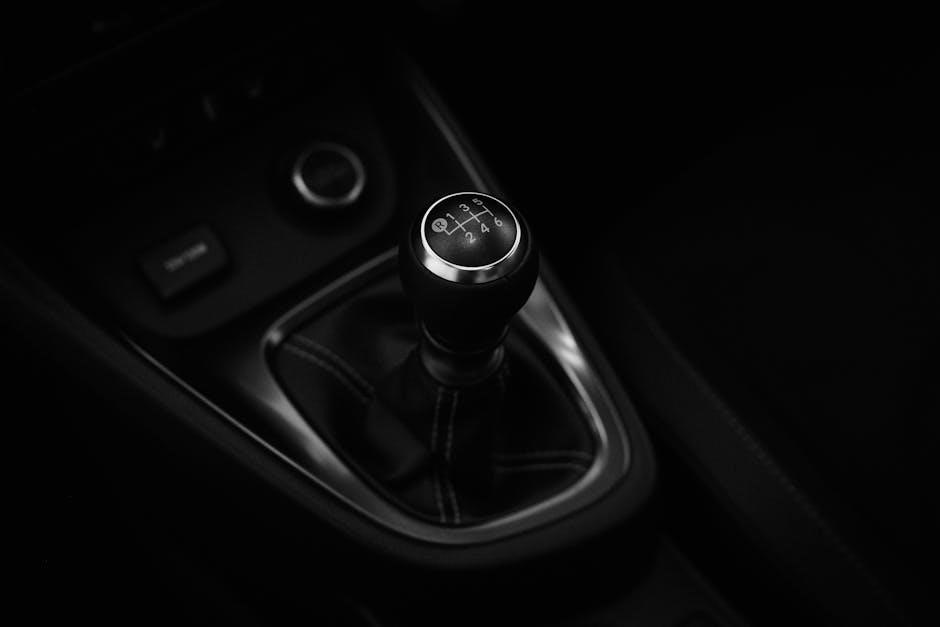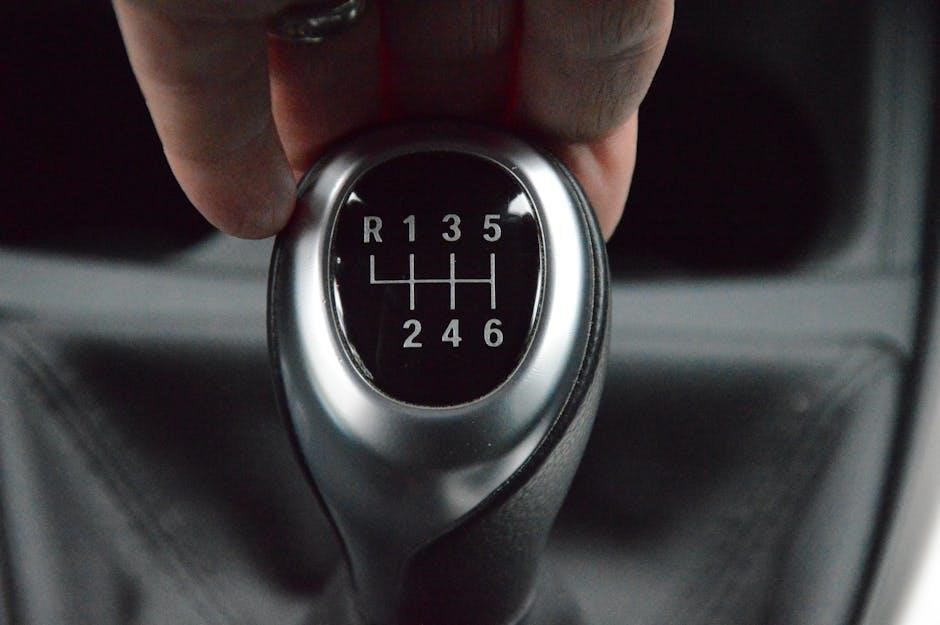The 5.3L engine‚ known for its durability and power‚ has gained popularity in manual transmission swaps despite not being originally paired with one. Enthusiasts often opt for the NV3500 or T56 for better control and performance‚ highlighting the growing interest in manual transmissions for this engine.
1.1 Overview of the 5.3L Engine and Its Compatibility with Manual Transmissions

The 5.3L Vortec and LS engines‚ known for their durability and power‚ are popular choices for manual transmission swaps. Originally paired with automatics‚ these engines can be adapted to manual transmissions with proper modifications. The NV3500 and T56 are common choices‚ offering reliability and performance. Compatibility requires specific adapters and bellhousings‚ ensuring a secure connection. Tuning the engine calibration is crucial for optimal performance‚ as manual transmissions demand different parameters than automatics. While the 5.3L engine wasn’t factory-equipped with a manual‚ enthusiasts have successfully integrated various transmissions‚ proving its versatility. This compatibility makes the 5.3L a favorite for custom builds and high-performance applications‚ despite the need for additional setup and tuning.
1.2 Importance of Manual Transmissions for the 5.3L Engine
Manual transmissions offer enhanced driver control and performance for the 5.3L engine‚ making them a preferred choice for enthusiasts. They provide better fuel efficiency and lower operating costs compared to automatics. The ability to optimize engine performance through precise gear shifts is a significant advantage. Additionally‚ manual transmissions are generally more durable and require less maintenance‚ reducing long-term expenses. For racing and high-performance applications‚ manuals are often the only viable option due to their strength and reliability. Moreover‚ the emotional connection of driving a manual transmission enhances the overall driving experience‚ making it a popular choice among car enthusiasts. This combination of performance‚ efficiency‚ and driver engagement highlights the importance of manual transmissions for the 5.3L engine in various automotive applications.

Evolution of Manual Transmissions for the 5.3L Engine
The 5.3L engine’s manual transmission evolution began with the NV3500‚ offering a cost-effective 5-speed option. Later‚ the T56 emerged as a high-performance 6-speed choice‚ enhancing drivability and durability.
2.1 Historical Background of GM Transmissions
GM’s transmission development dates back to the 1980s‚ with the introduction of the 700R4 and 2004R‚ focusing on fuel efficiency. These early models laid the groundwork for modern manual transmissions like the NV3500 and T56‚ which are now popular for the 5.3L engine swaps. The evolution reflects GM’s commitment to innovation‚ ensuring compatibility and performance across various engine configurations.
2.2 Development of Manual Transmissions for the 5.3L Vortec and LS Engines
The development of manual transmissions for the 5.3L Vortec and LS engines was driven by enthusiast demand for better control and performance. Initially‚ GM focused on automatics‚ but aftermarket solutions emerged to meet the need for manual options. The NV3500 and T56 became popular choices‚ offering durability and compatibility. These transmissions were often sourced from high-performance applications‚ ensuring they could handle the engine’s power. Adaptation kits and bellhousing modifications were developed to facilitate swaps‚ making manual transmissions more accessible for 5.3L engines. This evolution underscores the collaborative efforts of manufacturers and enthusiasts in enhancing the driving experience.

Popular Manual Transmission Options for the 5.3L Engine
Popular manual transmissions for the 5.3L engine include the NV3500‚ a cost-effective 5-speed‚ and the T56‚ a high-performance 6-speed. Other options like R154‚ AR5‚ and MA5 are also compatible.
3.1 NV3500: A Cost-Effective 5-Speed Manual Transmission
The NV3500 is a popular choice for 5.3L engine swaps due to its affordability and compatibility. This 5-speed manual transmission is known for its durability and smooth shifting‚ making it ideal for both street and light off-road use. Originally designed for GM trucks‚ the NV3500 pairs well with the 5.3L Vortec and LS engines‚ offering a reliable and cost-effective solution for enthusiasts. Its compact design and factory compatibility reduce the need for extensive modifications‚ while still providing the control and engagement of a manual transmission. The NV3500 is often recommended for budget-friendly swaps‚ proving to be a practical yet efficient option for drivers seeking a manual setup without breaking the bank.
3.2 T56: A High-Performance 6-Speed Manual Transmission
The T56 is a high-performance 6-speed manual transmission widely recognized for its strength and versatility. Originally used in high-power applications like the Chevrolet Camaro and Pontiac GTO‚ the T56 is well-suited for the 5.3L engine‚ offering crisp shifts and excellent durability. Its overdrive feature enhances fuel efficiency‚ while its robust design handles increased torque and horsepower. Enthusiasts favor the T56 for its reliability in both street and track environments. However‚ installing it with a 5.3L engine often requires adapters and specific bellhousing setups. Despite these considerations‚ the T56 remains a top choice for those seeking a high-performance manual transmission for their 5.3L swaps‚ delivering unmatched driving engagement and performance capabilities.
3.3 Other Compatible Manual Transmissions (R154‚ AR5‚ MA5)
Beyond the NV3500 and T56‚ enthusiasts exploring manual transmissions for the 5.3L engine have other viable options. The R154‚ a 5-speed unit from Toyota‚ is known for its strength and is often used in high-performance applications. The AR5 and MA5‚ both 5-speed transmissions‚ are compact and lightweight‚ making them ideal for smaller vehicles or those prioritizing fuel efficiency. These transmissions are highly adaptable‚ with aftermarket adapters and bellhousings enabling compatibility with the 5.3L engine. While they may require additional modifications‚ they offer unique advantages‚ such as lower cost or better fitment for specific builds. These options provide flexibility for those seeking alternatives to the more common NV3500 and T56‚ allowing for personalized performance and drivetrain configurations.

Challenges of Swapping to a Manual Transmission
Swapping to a manual transmission involves engine calibration‚ adapter compatibility‚ and drivetrain modifications. Fuel injection and spark timing adjustments are crucial‚ requiring precise tuning for smooth operation.
4.1 Engine Calibration and Tuning Requirements
Swapping to a manual transmission requires precise engine calibration and tuning‚ particularly for fuel injection and spark timing. Start with a 4.8L or 6.0L manual file‚ then adjust for the 5.3L’s displacement‚ fuel tables‚ and MAF values. Copy injector parameters and spark tables from the 5.3L to ensure proper combustion. Deceleration Fuel Cutoff (DFCO) parameters must be recalibrated to prevent stalling. Idle and low RPM timing adjustments are critical for smooth operation. Avoid engine segment swaps‚ as they may overwrite manual-specific settings. Use Universal Patcher to fine-tune parameters‚ focusing on minimal changes for fuel‚ air‚ and spark. Proper calibration ensures compatibility and performance‚ making the swap successful without compromising drivability.

4.2 Adapters and Bellhousing Compatibility
When swapping to a manual transmission‚ adapters and bellhousing compatibility are crucial. The Novak adapter and 621‚ 486‚ 697‚ or 444 bellhousings are commonly used with Gen III engines. These adapters ensure proper alignment with the 168-tooth flywheel‚ essential for manual transmissions. Motor mounts must also be compatible‚ as LS engines use a different pattern than traditional small-block Chevys. Using the correct adapter kit prevents leaks and misalignment. Incorrect bellhousing or adapter choices can lead to drivetrain issues. Always verify compatibility to ensure a smooth swap. Proper fitment guarantees reliability and performance‚ making adapters and bellhousings key components in the manual transmission swap process.
4.3 Drivetrain and Chassis Modifications
Swapping to a manual transmission often requires drivetrain and chassis modifications. The rear axle and driveshaft may need upgrading to handle increased torque. Four-wheel-drive systems need adjustments‚ as manual transmissions don’t inherently support transfer case integration. Chassis mounts and crossmembers might require reinforcement to accommodate the manual transmission’s weight and stress. Additionally‚ the clutch pedal and master cylinder must be installed correctly‚ and the brake system may need modification. Proper alignment of the driveshaft and ensuring the rear axle ratio matches the new transmission is essential for optimal performance. These modifications ensure the drivetrain operates smoothly‚ enhances durability‚ and maintains vehicle stability‚ making them critical steps in the swap process.

Technical Considerations
Engine calibration‚ fuel injection‚ and spark timing require precise adjustments for manual transmissions. Custom tuning ensures compatibility and optimal performance‚ addressing deceleration fuel cutoff and torque management parameters effectively.
5.1 Engine Segment Swaps and Parameter Adjustments
When transitioning from an automatic to a manual transmission with a 5.3L engine‚ precise adjustments are crucial. Engine segment swaps involve transferring key parameters from a manual calibration file to ensure compatibility. This includes updating fuel injection maps‚ spark timing‚ and airflow settings to match the manual transmission’s operation. Displacement adjustments from 4.8L to 5.3L must be accurately made to maintain performance. Additionally‚ parameters like idle speeds and torque management need fine-tuning to prevent issues such as deceleration fuel cutoff. These adjustments require careful tuning to avoid overwriting critical manual transmission-specific settings‚ ensuring smooth engine operation and optimal drivability.
5.2 Fuel Injection and Spark Timing Modifications
Fuel injection and spark timing modifications are essential when swapping to a manual transmission on a 5.3L engine. The engine control module (ECM) must be recalibrated to account for the manual transmission’s unique operating characteristics. Fuel injection parameters‚ such as fuel maps and injector pulse widths‚ need adjustment to ensure proper fuel delivery under varying throttle conditions. Spark timing must also be optimized to match the manual transmission’s shifting patterns and engine load variations. These modifications prevent issues like poor throttle response‚ misfires‚ or decreased performance. Tuning software is often used to fine-tune these settings‚ ensuring the engine runs smoothly with the manual transmission. Proper calibration is critical for maintaining efficiency and power output in the 5.3L engine when paired with a manual setup.
5.3 Deceleration Fuel Cutoff (DFCO) Parameters
Deceleration Fuel Cutoff (DFCO) parameters must be carefully adjusted when swapping to a manual transmission on a 5.3L engine. DFCO is a fuel-saving feature that cuts fuel injection during deceleration‚ but manual transmissions require different settings than automatics. Incorrect DFCO parameters can cause issues like engine stalling or rough running when decelerating. The engine calibration must be modified to account for the manual transmission’s unique deceleration characteristics. This involves tuning the ECM to ensure proper fuel cutoff and reactivation based on throttle position‚ engine speed‚ and load. Proper DFCO calibration is essential for smooth operation and to prevent drivability issues‚ especially in scenarios like downshifting or coasting. Tuning software is typically used to adjust these parameters for optimal performance with a manual setup.

Installation and Compatibility
Installing a manual transmission with a 5.3L engine requires careful consideration of bellhousing adapters‚ drivetrain compatibility‚ and proper engine calibration to ensure smooth operation and reliability.

6.1 Engine Compatibility with Manual Transmissions
The 5.3L engine’s compatibility with manual transmissions is well-documented‚ though it requires specific considerations. While the engine itself is robust‚ pairing it with a manual transmission demands careful adapter and bellhousing selection. The NV3500 and T56 are popular choices due to their bolt-on compatibility with the LS platform. However‚ enthusiasts often face challenges with the engine’s electronic controls‚ such as the throttle-by-wire system‚ which must be recalibrated for manual operation. Additionally‚ the engine’s Active Fuel Management (AFM) may need to be disabled to ensure proper functionality with a manual setup. Proper installation ensures optimal performance‚ making the 5.3L a versatile option for manual transmission swaps in various vehicles.
6.2 Bellhousing and Adapter Requirements
When swapping to a manual transmission with a 5.3L engine‚ proper bellhousing and adapter compatibility is crucial. The LS engine family‚ including the 5.3L‚ requires specific adapters to mate with manual transmissions like the NV3500 or T56. The Novak adapter is a popular choice‚ offering a bolt-on solution for GM bellhousings. Ensuring the correct bellhousing pattern (4-bolt vs. 3-bolt) is essential to avoid compatibility issues. Additionally‚ the 621 and 486 bellhousings are commonly used with the 5.3L‚ providing a secure connection to the transmission. Proper alignment and fitment of these components ensure smooth operation and prevent potential damage to the drivetrain. Always verify specifications to match the engine and transmission configuration for a seamless installation.
6.3 Drivetrain and Four-Wheel Drive Considerations
Integrating a manual transmission with a 5.3L engine in a four-wheel-drive setup requires careful drivetrain planning. The transfer case and driveshaft must be compatible with the new transmission’s output. For instance‚ the NV3500 and T56 transmissions often require custom driveshaft lengths and adapters to maintain proper drivetrain alignment. In 4WD configurations‚ ensuring the transmission’s output shaft matches the transfer case input is critical to avoid vibration and damage. Additionally‚ the electronic controls for four-wheel drive must be calibrated to work with the manual transmission‚ as automatic transmissions typically rely on different sensors and signals. Proper modifications to the drivetrain and transfer case setup are essential for maintaining the functionality and performance of the vehicle in both two-wheel and four-wheel drive modes.

Performance and Cost Considerations
Manual transmissions enhance driving control and efficiency for the 5.3L engine‚ with options like the NV3500 offering affordability and the T56 providing high-performance capabilities at a higher cost.
7.1 Performance Advantages of Manual Transmissions
Manual transmissions offer enhanced driving control and efficiency for the 5.3L engine. They provide better fuel economy‚ especially in city driving‚ by allowing drivers to optimize gear shifts; Additionally‚ manual transmissions typically weigh less than automatics‚ improving power-to-weight ratio and acceleration. The direct connection between the engine and wheels reduces torque loss‚ delivering more responsive performance. Enthusiasts appreciate the tactile experience of shifting gears‚ which enhances the driving engagement. Furthermore‚ manual transmissions often require less complex cooling systems and have fewer parasitic power losses‚ making them a preferred choice for performance-oriented applications. Overall‚ manual transmissions unlock the full potential of the 5.3L engine‚ offering a more dynamic and efficient driving experience.
7.2 Cost Comparison: Manual vs. Automatic Transmissions
Manual transmissions for the 5.3L engine are generally more cost-effective than automatics‚ both in upfront purchase and long-term maintenance. The NV3500 and T56 are affordable options‚ while high-performance manuals like the T56 Magnum may be pricier but offer durability. Automatic transmissions‚ especially the 4L60E‚ are more expensive initially and require costlier repairs. However‚ used automatics can be sourced cheaply. Fuel efficiency with manuals often offsets higher installation costs. Labor for manual swaps can be high due to adapter and bellhousing needs. Overall‚ manuals provide better value for performance enthusiasts‚ while automatics remain practical for everyday use. Balancing initial and long-term costs is key to choosing the right transmission for your 5.3L engine setup.
7.3 Budget-Friendly Options for Manual Transmission Swaps
For enthusiasts on a budget‚ the NV3500 and T5 are cost-effective manual transmission options for the 5.3L engine. The NV3500‚ a 5-speed unit‚ is affordable and compatible with factory applications‚ making it a popular choice. The T5‚ while older‚ offers a lower entry price but may require modifications for heavier-duty use. Used transmissions from salvage yards or forums can significantly reduce costs. Additionally‚ adapters and bellhousing kits from companies like Novak or Advance Adapters can help keep the swap economical. DIY installation and tuning with free or low-cost software can further cut expenses. While high-performance options like the T56 Magnum are pricier‚ budget-friendly alternatives ensure a manual swap remains accessible without sacrificing reliability or fun.
The 5.3L engine shines in manual transmission swaps‚ offering enhanced control and performance. Explore forums‚ guides‚ and transmission models like the NV3500 for detailed insights and support.
8.1 Final Thoughts on the 5.3L Manual Transmission
The 5.3L manual transmission swap offers a rewarding driving experience‚ combining the engine’s power with enhanced control. While challenges like calibration and compatibility exist‚ enthusiasts find the effort worthwhile for improved performance and driver engagement. Proper planning and research are crucial for a successful swap‚ ensuring optimal results.
8.2 Recommended Resources for Further Reading and Support
For those exploring the 5.3L manual transmission swap‚ several resources provide invaluable guidance. Forums like LS1Tech and GearHead-EFI offer detailed threads and expert advice. Websites such as Summit Racing and Tick Performance supply parts and installation kits. The TREMEC T56 Magnum is a popular choice‚ with support available through their official site. Additionally‚ YouTube channels like DEADBEATGARAGE share hands-on experiences. For tuning‚ Universal Patcher and TunerPro are essential tools. Books on LS engine swaps and local car communities can also offer practical insights. These resources collectively help enthusiasts navigate the complexities of a successful manual transmission installation and optimization.
